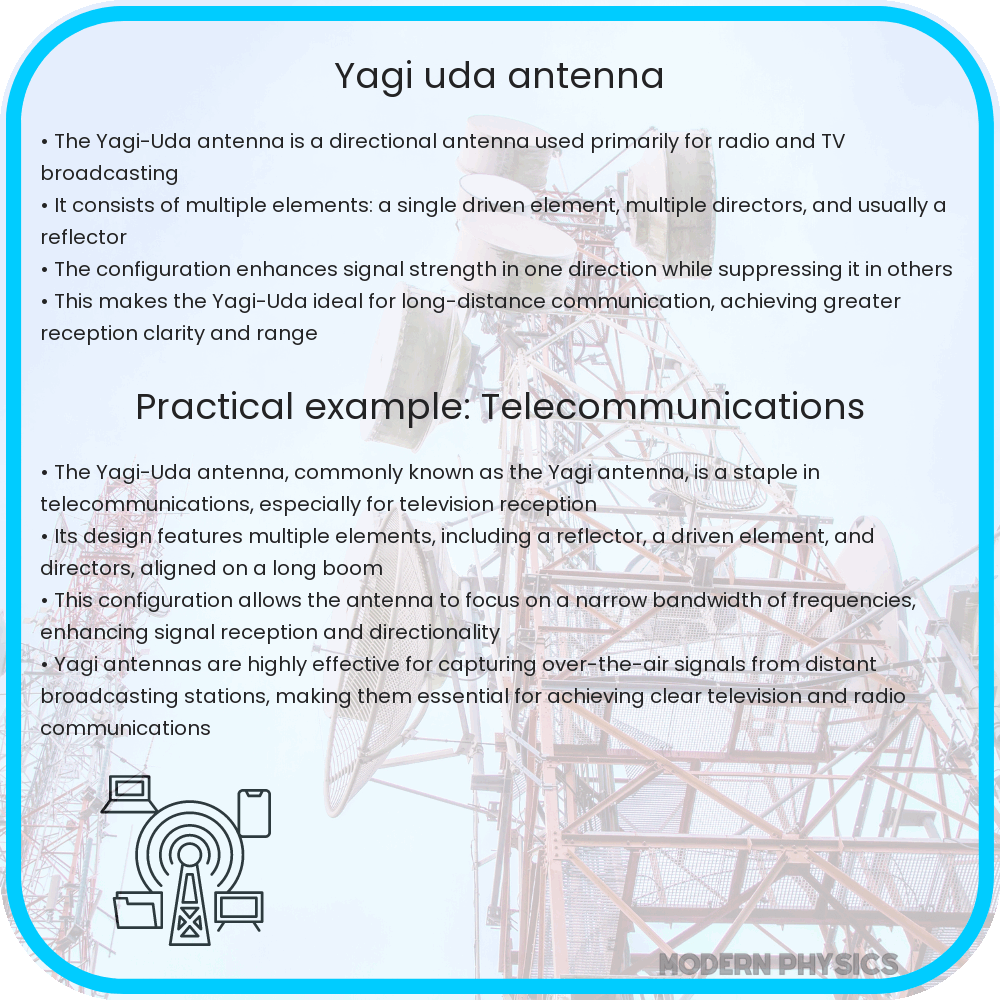Explore the Yagi-Uda antenna’s design, working principles, applications, and optimization strategies in modern communication technology.

Understanding the Yagi-Uda Antenna: Principles and Applications
The Yagi-Uda antenna, commonly known simply as the Yagi antenna, is a type of directional antenna widely used in communications and broadcasting. Its design, characterized by a series of parallel elements along a common axis, makes it highly efficient and capable of achieving significant gain. This article delves into the fundamental principles behind the Yagi-Uda antenna, its structure, and its widespread applications in modern technology.
Basic Structure and Design
The Yagi-Uda antenna typically consists of three key components: a driven element, a reflector, and one or more directors. The driven element is usually a dipole antenna and is directly connected to the transmission line. The reflector, placed behind the driven element, is slightly longer and helps enhance the antenna’s forward gain by reflecting energy towards the direction of radiation. The directors, situated in front of the driven element, are shorter and further refine the antenna’s directional capabilities.
Working Principle
The Yagi-Uda antenna operates on the principle of wave interference. The elements are spaced in such a way that the radio waves from different elements interfere constructively in the forward direction and destructively in the opposite direction. This results in a unidirectional radiation pattern with a high front-to-back ratio, making the antenna highly effective for long-distance communication in a specific direction.
Applications in Modern Technology
Due to its high gain and directionality, the Yagi-Uda antenna finds extensive use in various fields. It is commonly employed in television reception, amateur radio, and even in radar systems. Its ability to focus energy in a particular direction makes it an ideal choice for point-to-point communication links. Moreover, its relatively simple and cost-effective design adds to its popularity in commercial and residential applications.
Advantages of Yagi-Uda Antennas
The primary advantages of Yagi-Uda antennas include their high directional gain, which allows for efficient signal transmission and reception over long distances. Additionally, their design simplicity and ease of construction make them accessible for various applications. However, the antenna’s directional nature also implies that it must be accurately aimed at the signal source for optimal performance, which can be a limitation in some scenarios.
In the next section, we will explore the technical specifications, variations in design, and key considerations for optimizing Yagi-Uda antennas for specific applications.
Technical Specifications and Variations
The performance of a Yagi-Uda antenna is largely determined by the number and length of its elements. Increasing the number of directors, for instance, can enhance the antenna’s gain and directivity. The spacing between the elements is another critical factor, typically ranging from 0.1 to 0.3 wavelengths. The material used for the elements, usually metal such as aluminum or copper, also plays a role in the antenna’s efficiency and durability.
Optimizing Yagi-Uda Antennas
To optimize a Yagi-Uda antenna for specific applications, several factors need consideration. The length and spacing of the elements must be precisely calculated based on the intended operating frequency. Moreover, the antenna’s orientation and height above the ground can significantly impact its performance, especially in environments with physical obstructions or reflective surfaces.
Modern Developments and Enhancements
Advancements in technology have led to the development of enhanced versions of the Yagi-Uda antenna. Innovations include the use of computer-aided design to optimize element spacing and length, and the integration of new materials for improved performance and durability. Digital signal processing has also augmented the capabilities of Yagi-Uda antennas, particularly in applications like satellite communication and radar systems.
Challenges and Limitations
Despite its advantages, the Yagi-Uda antenna faces certain limitations. Its highly directional nature means it is less suitable for applications requiring omnidirectional coverage. Additionally, the antenna’s performance can be affected by environmental factors such as weather conditions and physical obstructions. Its size can also be a limiting factor, particularly for high-frequency applications where the antenna can become quite large.
Conclusion
The Yagi-Uda antenna stands out as a hallmark of efficient and directional radio frequency transmission. Its simple yet effective design has enabled its widespread use in various communication applications, from television reception to amateur radio. While it does have its limitations, the Yagi-Uda antenna’s ability to provide high gain in a specific direction continues to make it a valuable component in the field of wireless communication. As technology progresses, enhancements in design and materials are likely to further expand the capabilities and applications of this versatile antenna.
